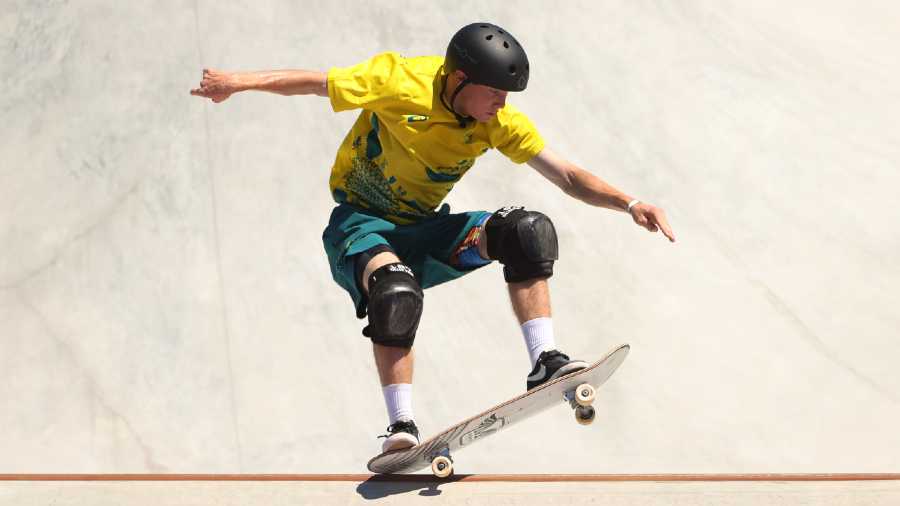During the inaugural men’s and women’s street skateboarding finals at the Tokyo Olympics, the best riders in the world fell. Repeatedly. They tumbled off steps and rails, hit the concrete, somersaulted, slid and loofahed any exposed skin. But after lying for a moment, most popped up, grabbed their boards and moved on to the next trick.
They gave a master class in how to wipe out well.
“Falling is commonplace if you are an athlete or physically active, even if you are young and fit,” said Jacob Sosn-off, a professor and associate dean of research at the University of Kansas Medical Center in Kansas City, US, who studies human movement and falls. “In fact, if you exercise much at all, I would say falls are almost inevitable at some point.”
Or, as Ryan Sheckler, a 31-year-old world-champion skateboarder and eight-time X Games medalist, told me, “Skateboarding is all about falling. It’s key to everything. If you aren’t falling, you aren’t learning. You have to hit the ground to progress.”
But falling during skateboarding or other sports and activities does not have to end in serious injuries and tears. Science and experience suggest that we can learn to fall more safely.
Tuck and roll
“Falling is easy,” Dr Sosnoff said. “Gravity does the work for you. It’s the landing that’s hard. You need to disperse the impacts when you strike the ground.”
In practice, this means you tuck and roll.
“A rolling movement helps to redistribute the energy that must be absorbed by the body over a larger contact area,” said Vivian Weerdesteyn, a professor of motor control and rehabilitation at Radboud University Medical Center and St. Maartens Clinic in the Netherlands and, at one time, a judo athlete with the Dutch junior national team.
The tuck and roll often is the first skill novice martial artistes learn, Dr Weerdesteyn said, and it can be quite effective.
So, next time you begin to fall to the side while standing, tuck in your chin to round your back and protect your head, move your arms opposite to the falling direction, squat at the knees, to lower your centre of gravity, and curl, shrimplike, into the direction of the fall. Depending on the height and direction of your tumble, you should aim to land on the meaty part of your upper back, below the shoulder blade, or on “that fleshy spot between the hip and buttocks,” Dr. Weerdesteyn said. As you hit the ground, continue rolling in the direction of the fall, until you naturally come to a stop. “Don’t fight the momentum” of the fall, she said. Flow with it.
This manoeuvre may sound daunting but is not difficult for most healthy people to master or deploy in an eyeblink, Dr Weerdesteyn said. In other experiments by her research group, young people picked up the technique after 30 minutes of supervised instruction.
Look down. Pad up
Helmets, kneepads, wrist guards and a stash of bandages also help if, tempted by the Olympics, you decide to sample a new sport. “Padding is pretty important” for novice skateboarders, Mr Sheckler said.
Ditto in other gravity sports. “Pads are the way to have the fun continue,” said Ryan Nyquist, the head coach for the United States BMX freestyle team and a 16-time BMX medalist at the X Games. BMX freestyle, which involves launching yourself and a BMX bike from features in a bicycle terrain park, made its Olympic debut in Tokyo.
Orient yourself in space, too, if you are above the ground, said Nina Williams, a professional rock climber with The North Face team. “Don’t close your eyes,” she said, if, for instance, you are on a bouldering wall at your local climbing gym and suspect you are about to fall. “Look down,” she said, check for obstacles, such as other climbers or their gear, and gently let go. “Don’t jump off,” she said. “Exhale and let yourself fall.”
Land on your feet, she continued. Then, of course, use your tuck and roll. “Don’t brace yourself,” Ms Williams said. “Stay loose.”
“Think ‘feet, knees, hips, elbows, shoulders,” Mr Nyquist said, and then roll like a rag doll from one to the next.
Try not to catch yourself with your hand and arm. But if, in some circumstances, you must, flex your wrists and elbows.
“If the choice is between hitting the ground with your head or an arm, use your arm,” Dr Sosnoff said. Relax and bend that arm, though, to absorb the impacts and reduce the chances of incurring a wrist or hand sprain or fracture.”
NYTNS










